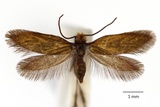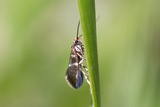Micropterix aruncella (Scopoli, 1763) Species
Last modified: Dec. 16, 2025, 6:22 p.m.
A fairly common species throughout Belgium.
Details
- Classification
- Family: Micropterigidae > Genus: Micropterix > Species: Micropterix aruncella
- Vernacular names
- Vroege oermot (NL), White-barred Gold, White-line Pollen-moth (EN)
- Synonyms
- Micropterix seppella (Fabricius, 1776)
- First mention in Belgium
- De Fré Ch. 1858. Catalogue des Microlépidoptères de la Belgique. — Annales de la Société entomologique belge 2: 45–162. On page 114 (as M.[icropteryx] Aruncella. Scop.). view page
- Status
-
Native
Distribution
Imago
Forewing ground colour bronzy golden with a purplish tinge at the base. Sexual dimorphism: the male has two silvery transverse lines – and sometimes a third diagonal streak in the apical region – which can be reduced to a silvery spot. The females without any such silvery pattern.
Cocoon/pupa
The cocoon of this species is tough.
Bionomics
This species hibernates as a larva and pupates in a tough cocoon in the upper layer of soil or among detritus. The imago, with its biting mouth parts, feeds on the pollen of many herbaceous plants but especially on Crataegus spp. Sometimes many adults are present on one flower. They are active during the daytime.
Flight periods
One generation a year from early May till the end of July.
Observed on
- Substrates:
- Herbaceous plants
The larva has been found on the tender, young growths of several herbaceous plant species, where it feeds on detritus.
Habitat
Dry and open habitats. It is not found in dense woodland.




